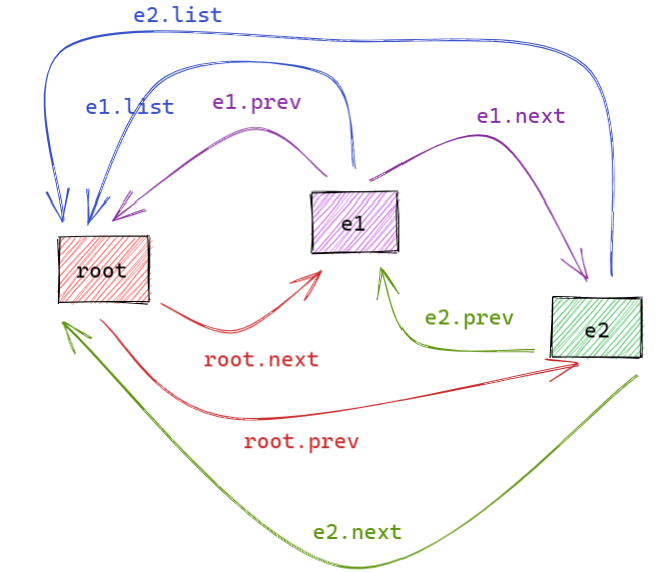Go 语言提供了 3 种容器双向链表 list,双向循环链表 ring 和堆 heap。
list 和 ring 的基本结构都是双向循环链表,但它们有一些区别,详见后文。
list
Go 语言中 list 是双向链表,其数据结构定义如下:
// 节点type Element struct {next, prev *Element // 后指针和前指针list *List // 归属于哪个链表Value interface{} // 值}// 双向链表type List struct {root Element // 根节点len int // 链表长度}
其图示结构如下:
可以看到,其结构非常巧妙:
- 链表的总体类型为 List,节点类型为 Element。
- 通过一个 *List 类型的变量指明每一个 Element 归属于那一条链表。
- 节点的值 Value 的类型为空接口类型 interface{},这表明它可以存储任何类型的值,int, string 等都可以,因此一条链表的元素类型是可以不相同的。
此外,虽然从结构上看 list 是一个双向循环链表,但如下遍历过程却不会循环输出:
for e := L.front(); e != nil; e = e.Next() { // L 是一条 list 链表fmt.Println(e.Value)}
原因是 Next() 的实现:
func (e *Element) Next() *Element {if p := e.next; e.list != nil && p != &e.list.root {return p}return nil}
可以看到如果 e.next == &e.list.root 的话,返回一个 nil,就避免了最后一个元素重新访问 root 节点。
提供的 API 如下:
// 属于 Element 的方法func (e *Element) Next() *Element // 返回当前节点的下一个节点的地址func (e *Element) Prev() *Element // 返回当前节点的前一个节点的地址// 属于 List 的方法func (l *List) Init() *List // 初始化一个链表,返回指向该链表的指针func (l *List) Len() int // 返回节点个数func (l *List) Front() *Element // 取链表的第一个节点func (l *List) Back() *Element // 去链表的最后一个节点func (l *List) PushFront(v interface{}) *Element // 往表头插入一个节点,返回该节点的地址func (l *List) PushBack(v interface{}) *Element // 往表尾插入一个节点,返回该节点的地址func (l *List) Remove(e *Element) interface{} // 删除 e 所指向的节点func (l *List) MoveToFront(e *Element) // 把节点 e 移到表头,e 必须属于该链表func (l *List) MoveToBack(e *Element) // 把节点 e 移到表尾,e 必须属于该链表func (l *List) PushBackList(other *List) // 把另一条链表 other 拼接到当前链表末尾func (l *List) PushFrontList(other *List) // 把另一条链表 other 拼接到当前链表表头func (l *List) MoveBefore(e, mark *Element) // 往 mark 节点前面插入一个节点 e,e 必须属于该链表func (l *List) MoveAfter(e, mark *Element) // 往 mark 节点后面插入一个节点 e,e 必须属于该链表func (l *List) InsertBefore(v interface{}, mark *Element) *Element // 往 mark 节点之前插入一个节点func (l *List) InsertAfter(v interface{}, mark *Element) *Element // 往 mark 节点之后插入一个节点// 包外访问方法func New() *List // 初始化一个链表,返回指向该链表的指针,对 Init() 的封装
栈和队列
在 Go 语言中没有专门封装栈和队列这两种数据结构,但是两者在实际应用中频繁且广泛,那么 Go 语言是如何解决这个问题的呢?
答案就是:使用 list 来实现。
栈的实现
使用 list 实现栈
stack := list.New() // 声明stack.PushBack(1) // 入栈e := stack.Back() // 取栈顶stack.Remove(e) // 出栈size := stack.Len() // 栈大小
使用切片实现栈
stack := make([]int, 0, 10) // 声明stack = append(stack, 1) // 入栈top := stack[0] // 取栈顶stack = stack[:len(stack)-1] // 出栈size := len(stack) // 获取栈的元素个数
这种方法有一个致命缺点:内存泄漏!
内存泄漏:向操作系统申请的内存空间,使用后却不归还,进行某些操作后,连自己都无法在访问它们,操作系统也不能对它们进行回收再利用。
比如像上述出栈操作 stack = stack[:len(stack)-1] 如果之前没有保存栈顶的地址(或其他访问它的方式),以后都无法再访问它,而它又属于切片 stack 的底层数组,因为还要用到这个底层数组的一部分,操作系统又不能回收掉这个底层数组。
队列的实现
使用 list 实现队列
// var queue list.List// queue.Init()queue := list.New() // 声明queue.PushBack(2) // 入队e := queue.Front() // 取队头queue.Remove(e) // 出队e = queue.Back() // 取队尾size := queue.Len() // 获取队列元素个数
使用切片实现队列
queue := make([]int, 0, 10) // 声明queue = append(queue, 1) // 入队front := queue[0] // 取队首back := queue[len(queue)-1] // 取队尾queue = queue[1:] // 出队size := len(queue) // 获取队列元素个数
同样存在内存泄漏的问题。
ring
heap
heap 包里定义了一组关于堆的接口,而且有关堆操作的方法的参数都必须是该接口类型的。
package heap// heap.Interfacetype Interface interface {sort.InterfacePush(x interface{}) // add x as element Len()Pop() interface{} // remove and return element Len() - 1.}func Init(h Interface)func Push(h Interface, x interface{})func Pop(h Interface) interface{}func Remove(h Interface, i int) interface{}func Fix(h Interface, i int)
package sorttype Interface interface {Len() intLess(i, j int) boolSwap(i, j int)}
因此根据“接口即约定”,若一个具体类型想使用接口中的方法,则必须实现该接口中的所有方法,让该具体类型具有该接口类型。
因此,我们先实现 heap.Interface,下面直接贴官方例子,打些注释
package mainimport ("container/heap""fmt")// 整型最小堆type IntHeap []int// 定义如何获取堆中元素的个数func (h IntHeap) Len() int { return len(h) }// 定义堆中的元素的大小顺序func (h IntHeap) Less(i, j int) bool { return h[i] < h[j] } // 最小堆,换成 > 则为最大堆// 定义如何交换堆中的两个元素func (h IntHeap) Swap(i, j int) { h[i], h[j] = h[j], h[i] }// 直接往尾部添加func (h *IntHeap) Push(x interface{}) {*h = append(*h, x.(int))}// 取最后一个元素func (h *IntHeap) Pop() interface{} {old := *hn := len(old)x := old[n-1]*h = old[0 : n-1]return x}func main() {h := &IntHeap{2, 1, 5}heap.Init(h)heap.Push(h, 3)fmt.Printf("minimum: %d\n", (*h)[0])for h.Len() > 0 {fmt.Printf("%d ", heap.Pop(h))}}
再看官方的一个经典例子:
package mainimport ("container/heap""fmt")// 优先队列中的元素type Item struct {value stringpriority int// The index is needed by update and is maintained by the heap.Interface methods.// 下标在 update 操作时需要,由 heap.Interface 中的方法维护index int // The index of the item in the heap.}// 实现 heap.Interface 并保存元素type PriorityQueue []*Itemfunc (pq PriorityQueue) Len() int { return len(pq) }func (pq PriorityQueue) Less(i, j int) bool {return pq[i].priority > pq[j].priority // 根据优先级建立最大堆}func (pq PriorityQueue) Swap(i, j int) {pq[i], pq[j] = pq[j], pq[i]// 仔细思考一下为什么下标要换回来pq[i].index = ipq[j].index = j}func (pq *PriorityQueue) Push(x interface{}) {n := len(*pq)item := x.(*Item)item.index = n*pq = append(*pq, item)}func (pq *PriorityQueue) Pop() interface{} {old := *pqn := len(old)item := old[n-1]old[n-1] = nil // 避免内存泄漏item.index = -1 // 确保安全*pq = old[0 : n-1]return item}// 修改了 priority 或 value 后会破坏堆的性质,该方法用于调整堆以恢复堆性质func (pq *PriorityQueue) update(item *Item, value string, priority int) {item.value = valueitem.priority = priorityheap.Fix(pq, item.index)}func main() {items := map[string]int{"banana": 3, "apple": 2, "pear": 4,}pq := make(PriorityQueue, len(items))i := 0for value, priority := range items {pq[i] = &Item{value: value,priority: priority,index: i,}i++}heap.Init(&pq) // 建堆item := &Item{value: "orange",priority: 1,}heap.Push(&pq, item) // 添加一个元素pq.update(item, item.value, 5) // 修改一下优先级// 依次出堆for pq.Len() > 0 {item := heap.Pop(&pq).(*Item)fmt.Printf("%.2d:%s ", item.priority, item.value)}}

